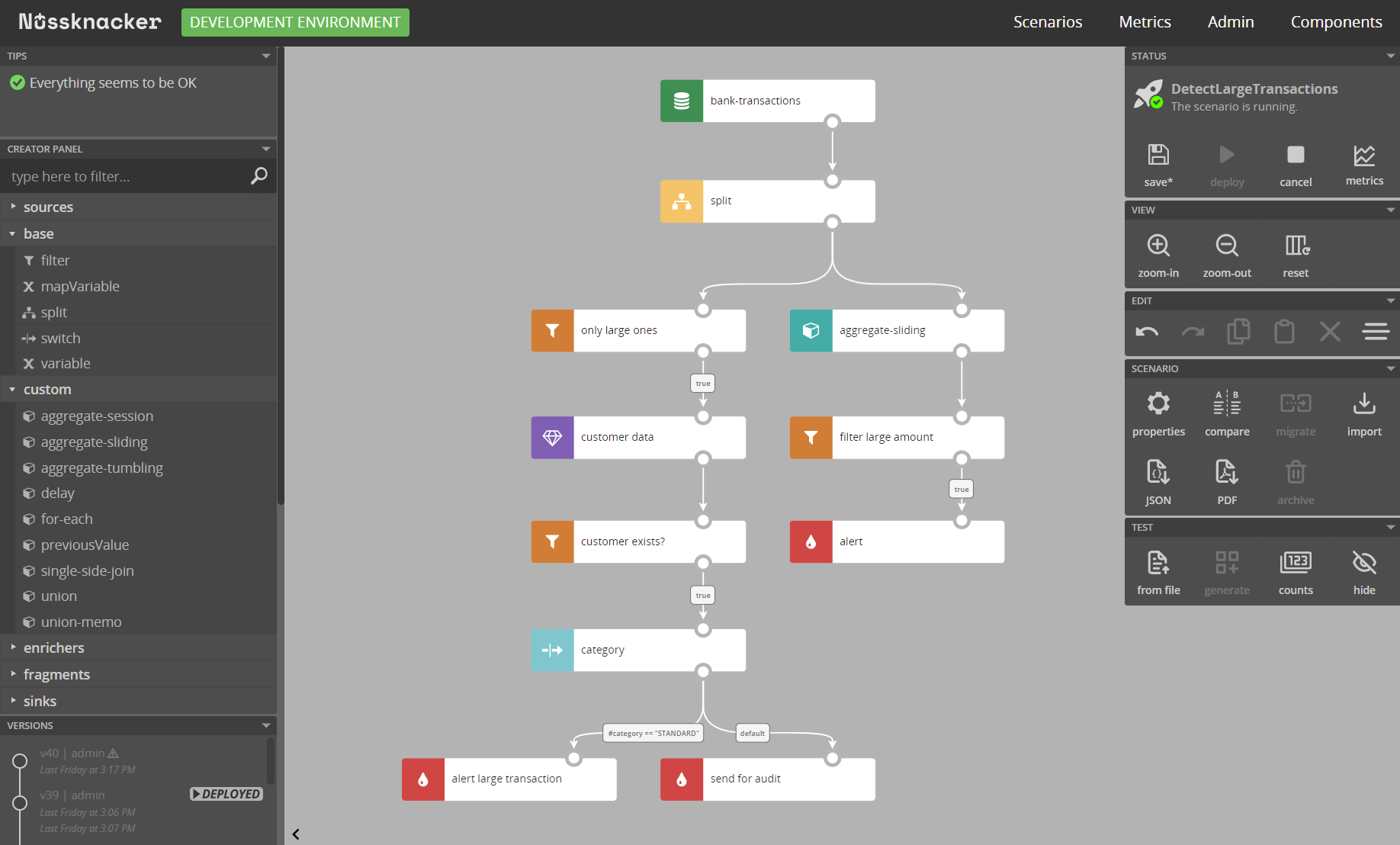
Research
Security News
Malicious npm Packages Inject SSH Backdoors via Typosquatted Libraries
Socket’s threat research team has detected six malicious npm packages typosquatting popular libraries to insert SSH backdoors.
pl.touk.nussknacker:nussknacker-benchmarks_2.12
Advanced tools

Nussknacker is a low-code visual tool for domain experts to build, run and monitor real-time decision algorithms instead of implementing them in the code.
In all IT systems, no matter the domain, decisions are made all the time. Which offer should a customer get? Who should receive a marketing message? Does this device need servicing? Is this a fraud?
Algorithms for making such decisions can be developed by programmers. With Nussknacker however, such decision algorithms can be authored and deployed without the need to involve IT.
An essential part of Nussknacker is a visual design tool for decision algorithms (scenarios in Nussknacker's speak). It allows not-so-technical users, like analysts or business people, to author decision logic in an imperative, easy-to-follow and understandable way. Scenario author uses prebuilt components to define the decision logic - routing, filtering, data transformations, aggregations in time windows (Flink engine only - see below), enrichments with data from external databases or OpenAPI endpoints, applications of ML models, etc. Once authored, with a click of a button, scenarios are deployed for execution. And can be changed and redeployed anytime there’s a need.
The way the data are processed and the features available depend on the processing mode and engine used.
Nussknacker supports two processing modes: streaming and request-response. In streaming mode, Nussknacker uses Kafka as its primary interface: input streams of data and output streams of decisions. In request-response mode, it exposes HTTP endpoints with OpenAPI definitions.
Support for batch processing mode is in active development and is planned to be released soon. For a preview, check out our blog post.
There are two engines to which scenarios can be deployed: Flink and Lite. Check out this document to understand which of the two fits your use case better.
Nussknacker is a tool for those who want to act on real-time data as easily as it is with data at rest and spreadsheets. Hundreds of millions of non-programmers create spreadsheets to crunch data at rest these days. The same should be possible with real-time data - and this is our promise with Nussknacker. If this promise is fulfilled, domain experts and developers can focus on tasks that each group is most happy to perform. Domain experts can author the decision algorithms and developers can solve problems beyond the reach of tools like Nussknacker.
We discovered that several factors heavily influence the development of algorithms that work with real-time data, including expectations placed on the tools used:
Check out this document for a concise summary of Nussknacker features.

Nussknacker is typically used as a component of a larger system, but it can be used as an end-to-end solution too. The use cases follow a common pattern: a program working on a data stream, file or in a request-response interaction style, receives a set of data (event or request) and has to deliver a decision. To “take” the decision it needs to perform one or more of the following: discard irrelevant records, enrich incoming records with data from external sources, aggregate events in time windows (if working on a data stream), run one or more ML models, compute the decision and finally deliver it either as another data stream, file or a response. The ‘decisions’ can be from a broad spectrum of vertical and horizontal applications:
To run Nussknacker on your host as quickly as possible, just copy and paste the following code into your terminal:
curl -o- https://raw.githubusercontent.com/TouK/nussknacker-quickstart/main/download-and-start.sh | bash
To learn more about this quickstart please visit the quickstart guide.
Talk to us on mailing list or start a discussion
Currently, we do support Scala 2.12 and 2.13, we cross publish versions. Default Scala version is 2.13. Docker images (both Designer and Lite Runtime) are tagged with _scala-2.X suffix (e.g. 1.8.0_scala_2.13 or latest_2.12).
Tags without such suffix are also published, and they point to images with default Scala version build. Please be aware of that, especially if you use latest image tag.
We currently support only one Flink version (more or less the latest one, please see flinkV in build.sbt). However, it should be possible to run Nussknacker with older Flink version.
While we don't provide out-of-the-box support as it would complicate the build process, there is separate repo with detailed instructions how to run Nussknacker with some of the older versions.
Nussknacker is an open source project - contribution is welcome. Read how to do it in Contributing guide. There you can also find out how to build and run development version of Nussknacker.
Nussknacker is published under Apache License 2.0.
By using Nussknacker you accept the Privacy Policy.
FAQs
nussknacker-benchmarks
We found that pl.touk.nussknacker:nussknacker-benchmarks_2.12 demonstrated a healthy version release cadence and project activity because the last version was released less than a year ago. It has 0 open source maintainers collaborating on the project.
Did you know?

Socket for GitHub automatically highlights issues in each pull request and monitors the health of all your open source dependencies. Discover the contents of your packages and block harmful activity before you install or update your dependencies.

Research
Security News
Socket’s threat research team has detected six malicious npm packages typosquatting popular libraries to insert SSH backdoors.

Security News
MITRE's 2024 CWE Top 25 highlights critical software vulnerabilities like XSS, SQL Injection, and CSRF, reflecting shifts due to a refined ranking methodology.

Security News
In this segment of the Risky Business podcast, Feross Aboukhadijeh and Patrick Gray discuss the challenges of tracking malware discovered in open source softare.